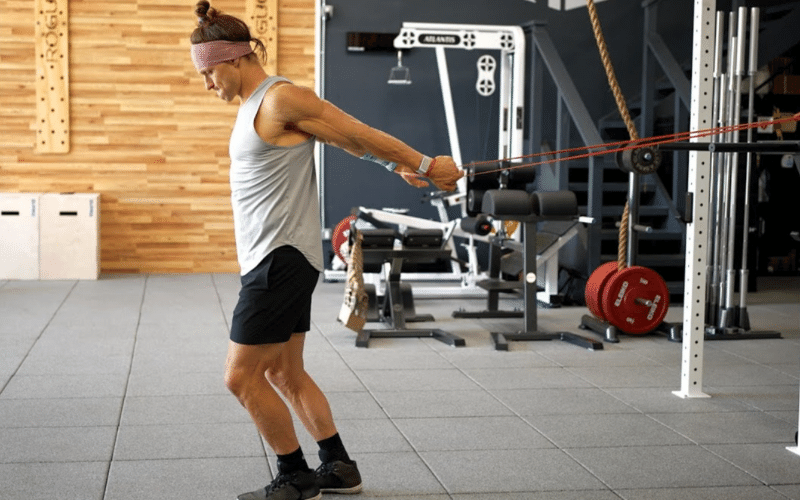Table of Contents

The shoulder extension exercise is an incredible exercise for targeting the shoulder muscles. The shoulder is a complex joint that has to be treated with more care than other joints because of their anatomical position. Stabilizing muscles are usually overdeveloped compared to the agonists, leading to pathological conditions if not given attention.
Shoulder Flexion and Extension Muscles Worked
Anterior Deltoids, Coracobrachialis, Pectoralis Major and Minor, and Subscapularis.
Posterior Deltoid and Latissimus Dorsi.
Triceps Brachii and Teres Major.
Rhomboids and Serratus Anterior.
Shoulder Extension Benefits
Improves flexibility in shoulder muscles and tendons.
Increases mobility of the arm, improving the function of the deltoids.
Helps avoid strains on biceps tendon during flexion.
How to do Shoulder Extensions
1. Stand upright with the arms bent to about 90 degrees and parallel to the ground.
2. Keep this position as you lift the arms upwards, maintaining a straight line between the shoulder and elbow.
3. Once they reach your ears, lower them back down slowly before repeating.
4. Maintain a steady pace throughout the exercise.
5. Do not bend or curve your back to compensate for a lack of strength in the shoulder muscles.
Shoulder Extension Precautions
When performing the shoulder extension, do not use momentum to complete repetitions of this exercise. This can lead to injury by causing loads that are too heavy for the joints involved, especially at their vulnerable anatomical position.
Do not force the exercise if you feel pain in your shoulder or elbow joints. This can be a sign of a serious problem and should be evaluated by a medical professional before resuming a training routine.
When your training routine calls for heavy loads, consider using lighter weight but more repetitions to reduce the risk of injury.
Take 48 hours to recover between sessions that work the same muscle groups. This allows your muscles time to repair and grow stronger before putting them under stress again.
Shoulder Flexion and Extension Stretch:
Sit on the floor with your feet shoulder-width apart and your knees bent at 90 degrees.
Raise both arms, then bend to one side as you bring that arm behind your head and grab the elbow of the other arm with your free hand. If you can’t reach, hold a towel in each hand for added grip.
Gradually pull your bent elbow towards the opposite ear until you feel a stretch in the shoulder. Hold for 30 seconds, then repeat on the other side.
Shoulder Extension Risk Factors Involved
Previous injuries to shoulders or elbows can cause pain which is worsened by performing this stretch. If this happens, stop immediately and contact a medical professional.
People with a smaller than average range of motion in their shoulders may find it difficult to complete the full range of motion for this stretch, which can also cause pain and injury if continued. If this is the case, simply perform the stretch as far as you comfortably can without feeling any pain.
Shoulder Extension Alternatives
If you cannot perform this stretch for any reason, there are many other stretches that target the shoulder joint so you can still have a complete training routine.
The arm behind your back also works the same muscles as this exercise and is an excellent alternative. Stand upright with your feet hip-width apart and arms by your side.
Bend to one side as you bring that arm behind your back. Reach for your elbow if it does not touch, offering a bit of resistance with the free hand if necessary.
Gradually pull your bent elbow towards the opposite ear until you feel a stretch in the shoulder. Hold for 30 seconds, then repeat on the other side.
Another alternative to the shoulder extension is to stand upright and hold your arms at 90 degrees as if you were holding dumbbells.
Bend forward slowly until you feel a stretch in the upper back. Hold for 30 seconds, then stand up and repeat.
For those who wish to stretch the muscles surrounding the shoulder joint but do not want to put undue stress on their elbows, the chest stretch is a good option.
Stand upright and hold your arms out to either side at shoulder height.
Gradually bring them together in front of you until you feel a stretch in the chest. Hold for 30 seconds, then repeat.
A partner can help you stretch the muscles surrounding your shoulder joint by pushing down on it if you do not have a lot of strength in this area.
Stand upright and raise one arm in the air so your partner can see your bicep. Grasp both hands together behind your back so they are supporting each other.
Bend forward slightly to add some weight, making sure not to bend at the waist. Your partner should resist your movement by pushing down on your back.
Hold for 30 seconds, then repeat with the other arm.
It’s important to make sue you are using correct form when doing shoulder extension exercises. Following these simple guidelines can help you take care of your shoulder joint to avoid pain or serious injury. Review them often as part of a complete training routine that includes diet, cardio, strength training and stretching.
[wp-stealth-ads rows=”2″ mobile-rows=”2″]

